Introduction
Stir-fried pork liver, a beloved dish in many Asian cuisines, is celebrated for its rich flavor, tender texture, and nutritional benefits. Often overlooked in Western cooking, this dish holds a special place in Chinese, Korean, and Southeast Asian kitchens, where it is prized for its ability to transform a humble ingredient into a culinary masterpiece. The key to achieving restaurant-quality stir-fried pork liver at home lies in mastering the balance of flavors, textures, and cooking techniques. This article will guide you through every step of the process, from selecting the freshest ingredients to executing the perfect stir-fry. Whether you are a seasoned home cook or a curious novice, this comprehensive guide will equip you with the knowledge and skills to create a dish that is both comforting and impressive.
The Allure of Stir-Fried Pork Liver
Pork liver, with its earthy, metallic tang and velvety texture, is a polarizing ingredient. When prepared correctly, it becomes a tender, flavorful delight that melts in your mouth. However, overcooking can render it tough and grainy, while under-seasoning leaves it bland and unappetizing. Stir-frying, a technique that combines high heat, rapid cooking, and bold seasonings, is the ideal method to elevate this often-maligned ingredient. The process sears the liver quickly, sealing in its natural juices while allowing aromatic ingredients like garlic, ginger, and scallions to infuse it with depth. The result is a harmonious blend of umami-rich flavors and contrasting textures that make stir-fried pork liver a standout dish.
Ingredients: Building the Foundation of Flavor
To create a memorable stir-fried pork liver, you must begin with quality ingredients. Each component plays a crucial role in balancing the dish’s flavors and textures.
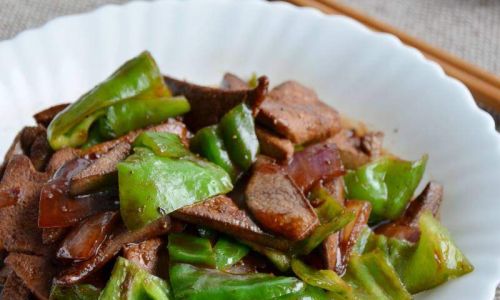
-
Pork Liver (400–500 grams):
- Choose fresh, deep red liver with a smooth, glossy surface. Avoid liver with a brownish hue or dry patches, as these indicate age or improper storage.
- For optimal tenderness, select a lobe with minimal connective tissue.
-
Aromatics:
- Garlic (6–8 cloves): Provides a pungent, savory base.
- Ginger (1-inch knob): Adds warmth and cuts through the liver’s richness.
- Scallions (4–5 stalks): Contribute freshness and a mild oniony note.
-
Vegetables:
- Onion (1 medium): Caramelizes slightly during cooking, adding sweetness.
- Bell Pepper (1 large, any color): Offers crunch and a hint of sweetness.
- Chili Peppers (2–3, optional): Adjust to taste for heat.
-
Sauce Base:
- Soy Sauce (3 tablespoons): Use dark soy sauce for depth or light soy sauce for saltiness.
- Oyster Sauce (1 tablespoon): Enhances umami and richness.
- Rice Wine or Shaoxing Wine (1 tablespoon): Deglazes the pan and adds complexity.
- Sugar (1 teaspoon): Balances the dish’s savory notes.
- Cornstarch (1 teaspoon): Thickens the sauce and tenderizes the liver.
-
Seasonings and Oils:
- Sesame Oil (1 teaspoon): Adds nutty aroma.
- White Pepper (¼ teaspoon): Subtle heat without overwhelming.
- Peanut or Vegetable Oil (3 tablespoons): High smoke point for stir-frying.
Preparation: The Key to Tender Perfection
The success of stir-fried pork liver hinges on meticulous preparation. Each step—cleaning, slicing, and marinating—ensures the liver cooks evenly and absorbs flavors.
-
Cleaning the Liver:
- Rinse the liver under cold water to remove any blood or impurities.
- Pat dry with paper towels. Trim away visible connective tissue or membranes using a sharp knife.
-
Slicing Technique:
- Slice the liver against the grain into thin, uniform strips (about ¼-inch thick). This ensures tender bites and even cooking.
- Soak the slices in cold water for 15–20 minutes to remove excess blood, which reduces gaminess. Drain and pat dry.
-
Marinating for Tenderness:
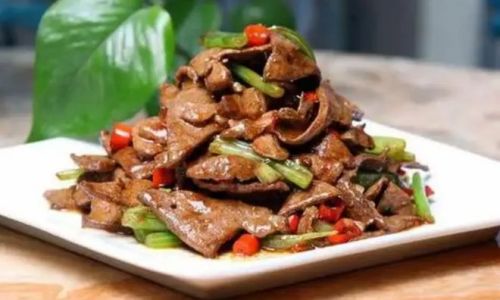
- In a bowl, combine the liver slices with 1 tablespoon soy sauce, 1 teaspoon cornstarch, 1 teaspoon rice wine, and a pinch of white pepper.
- Mix gently and let marinate for 20–30 minutes. This step tenderizes the meat and seasons it thoroughly.
-
Prepping Aromatics and Vegetables:
- Mince garlic and ginger finely. Slice scallions into 1-inch segments, separating whites and greens.
- Cut onions into wedges and bell peppers into thin strips.
Cooking Process: Mastering the Stir-Fry
Stir-frying is a dance of heat, timing, and motion. Achieving the perfect texture requires precision and attention to detail.
-
Heating the Wok:
- Place a wok or large skillet over high heat. Add 2 tablespoons of oil and swirl to coat the surface.
- Wait until the oil shimmers and begins to smoke slightly—this indicates it’s hot enough for searing.
-
Searing the Liver:
- Add the marinated liver to the wok, spreading it in a single layer. Let it sear undisturbed for 30–40 seconds to develop a golden crust.
- Toss the liver gently using a spatula or wok ladle, stirring continuously for 1–2 minutes until it’s mostly cooked but still slightly pink in the center. Overcooking at this stage will result in toughness.
- Transfer the liver to a plate and set aside.
-
Stir-Frying Aromatics and Vegetables:
- Reduce the heat to medium-high and add the remaining tablespoon of oil.
- Toss in the garlic, ginger, and scallion whites. Stir-fry for 30 seconds until fragrant.
- Add onions and bell peppers, increasing the heat to high. Stir-fry for 2–3 minutes until the vegetables are crisp-tender.
-
Combining and Finishing:
- Return the liver to the wok. Pour in the sauce mixture (soy sauce, oyster sauce, rice wine, sugar, and a splash of water).
- Toss everything together rapidly, ensuring the liver and vegetables are coated evenly. Cook for 1–2 minutes until the sauce thickens slightly.
- Drizzle with sesame oil and sprinkle scallion greens. Toss once more and remove from heat.
Tips for Tender, Flavorful Pork Liver
-
Avoid Overcrowding the Wok:
Cook the liver in batches if necessary. Overcrowding lowers the wok’s temperature, leading to steaming instead of searing.
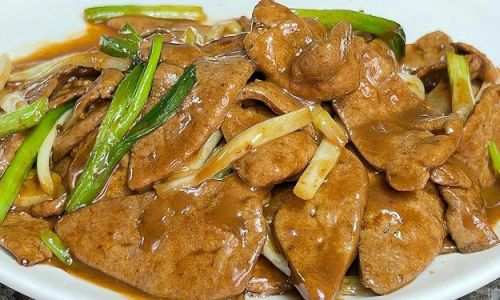
-
Master the Marinade:
The cornstarch in the marinade acts as a protective coating, preventing the liver from drying out. Do not skip this step.
-
Timing Is Everything:
The liver continues to cook slightly after being removed from the heat. Aim for a slight pinkness in the center to ensure tenderness.
-
Adjust Seasonings to Taste:
Taste the sauce before adding it to the wok. Adjust soy sauce or sugar levels based on your preference.
Serving Suggestions and Pairings
Stir-fried pork liver pairs beautifully with steamed jasmine rice, which absorbs the flavorful sauce. For a complete meal, serve it alongside:
- Stir-Fried Greens: Bok choy, gai lan, or spinach add freshness.
- Pickled Vegetables: A tangy side dish like pickled cucumbers or daikon balances the richness.
- Congee or Noodles: For a heartier dish, serve over congee or toss with egg noodles.
Regional Variations and Creative Twists
-
Sichuan-Style Spicy Pork Liver:
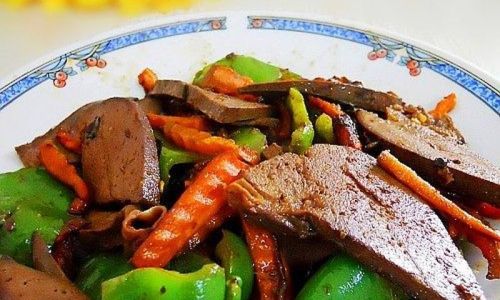
Add doubanjiang (fermented chili bean paste) and Sichuan peppercorns to the sauce for a numbing, spicy kick.
-
Korean-Inspired Gochujang Glaze:
Substitute the soy sauce mixture with a blend of gochujang, honey, garlic, and rice vinegar.
-
Vietnamese Caramelized Pork Liver:
Simmer the liver in a caramel sauce made from palm sugar, fish sauce, and lime juice for a sweet-savory twist.
Health Benefits and Dietary Considerations
Pork liver is a nutritional powerhouse, rich in iron, vitamin A, and B vitamins. However, it is also high in cholesterol, so moderation is key, especially for those with dietary restrictions. To reduce cholesterol, trim excess fat and pair the dish with fiber-rich vegetables.
Troubleshooting Common Issues
- Tough Liver: Overcooking is the primary culprit. Ensure the liver is seared quickly and removed from the heat while still slightly pink.
- Bland Flavor: Increase the marinating time or add more aromatic ingredients like ginger or garlic.
- Soggy Vegetables: Stir-fry vegetables separately and add them at the end to maintain crispness.
Conclusion: The Joy of Perfecting a Classic
Stir-fried pork liver is more than a dish—it’s a testament to the transformative power of careful preparation and precise cooking. By mastering the art of marinating, searing, and balancing flavors, you can turn a simple ingredient into a culinary triumph. Whether enjoyed as a weeknight meal or a centerpiece at a dinner party, this dish rewards patience and practice with unparalleled flavor. So, grab your wok, sharpen your knife, and embark on a journey to savor the delicate balance of earthy, savory, and sweet that defines stir-fried pork liver. Your taste buds—and your dinner guests—will thank you.
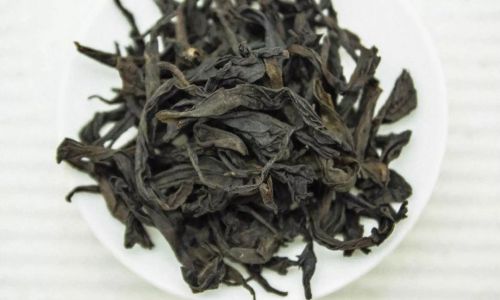
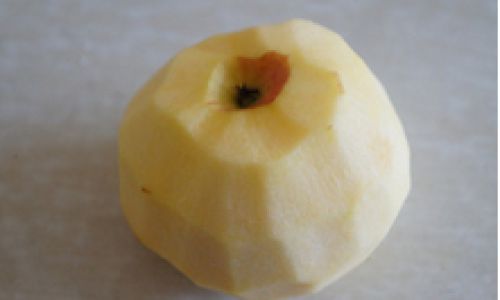


0 comments